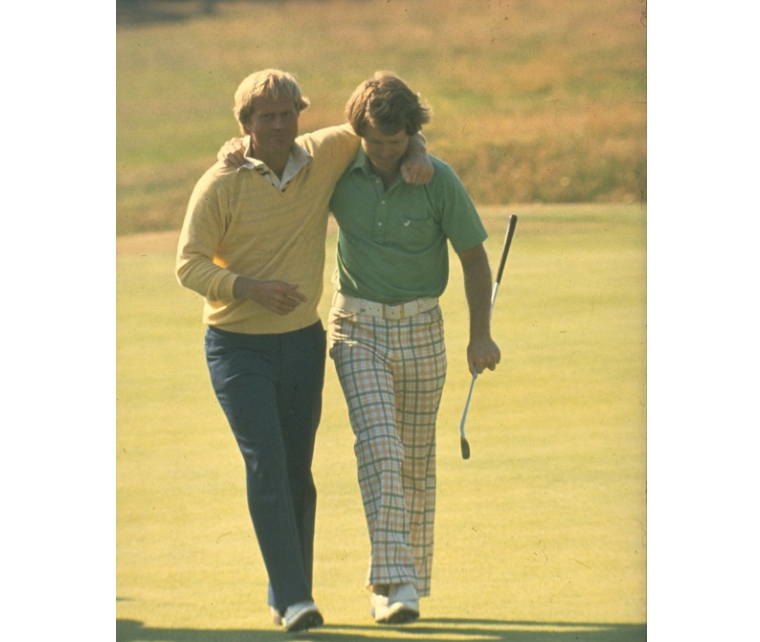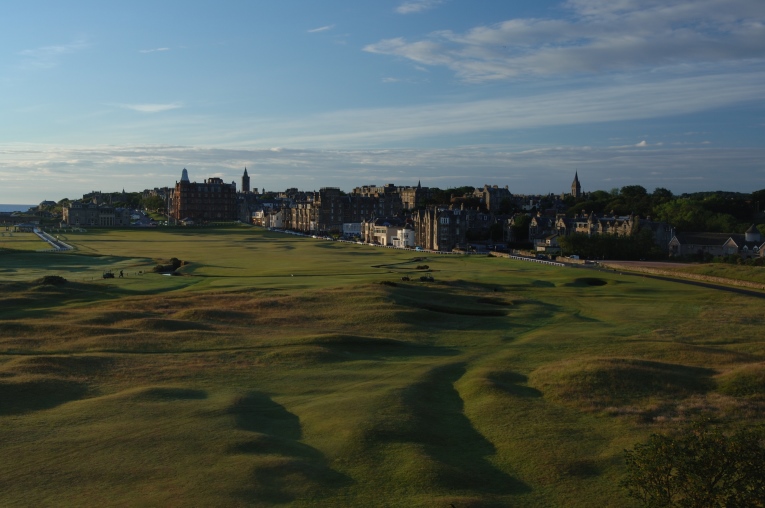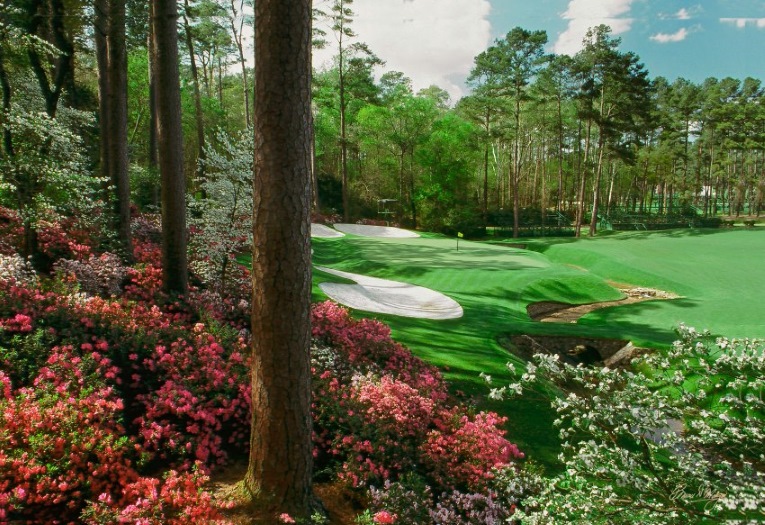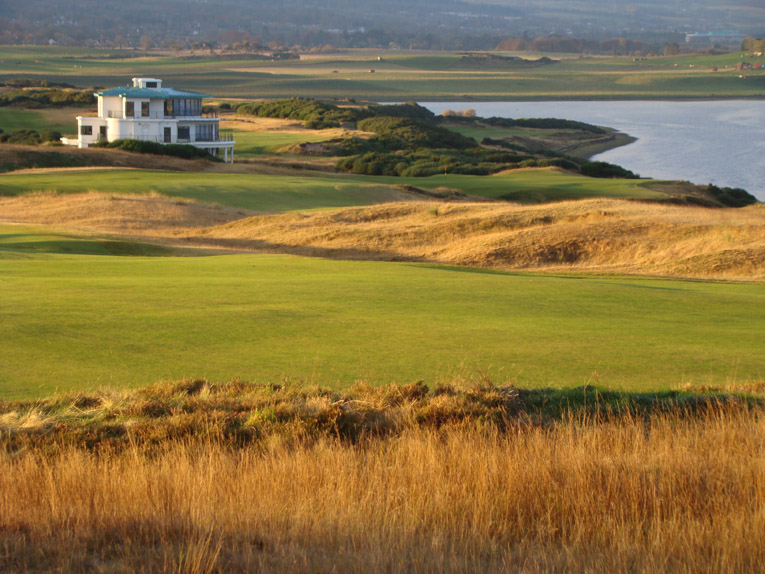Feature Interview with Brian Morgan
March, 2016
How did you get started in the photography business?
I started very young in the photography business. Left school at 15 years of age and went to work in the Photographic Department of John Brown’s shipyard in my hometown of Clydebank near Glasgow. The shipyard was world famous for building all the great Cunard Liners, Queen Mary, etc. While there, the QE 2 was on the stocks being constructed. I moved on after only one year to work for a well known Glasgow wedding photographer and was quickly photographing weddings.
What was your first golf assignment?
My first photo assignment as a professional was at the wedding photographers doing passport pictures. When I went to England at 18 years of age, I covered many soccer games with Liverpool, Manchester United, etc. While I worked there for a freelance photographer, I covered my first golf tournament, The Ryder Cup at Royal Birkdale in 1965.
Share with us three highlights.
First highlight of my career was covering the 1977 Open Championship at Turnberry where Watson and Nicklaus went head to head over the final 36 holes. The photograph attached is “Shared Glory” with the two walking off the final green arm-in-arm.
Second highlight was covering the first win by Europe on American soil at Muirfield Village.
Third highlight was being totally involved with Jack Nicklaus when he won the Masters in 1986. I was working a lot for the Nicklaus company doing everything from family photos to new golf courses and I was lucky enough to be in the right spot on the 15th hole in the final round when he made that Eagle. Because of the angle, I had decided to shoot it loose (not close up with a very long lens but leaving enough space around for the scoreboard etc.). When Jack holed the putt, his son Jackie jumped in the air with his hands held high and it remains as one of my most iconic photographs, naturally called “The Eagle.”
What was a lowlight?
A lowlight has to be the unexpected turnaround in a deal which involved my library of over 400,000 images. A company introduced to me by the Nicklaus organization negotiated a deal with me to purchase my archive with all the intellectual property rights for several million dollars. On top of that was a book deal and a royalty to print sales which would have given me a good yearly income. Only weeks before they were due to pay for the library they announced that the funding had fallen through. I still have the 400,000 images.
How have you evolved as a photographer over the last five (!) decades?
I have had to evolve from shooting on high quality transparency film to digital. The shooting just became easier but the post-processing and handling of large files has been a huge learning experience. I had no computer knowledge prior to starting to try out digital cameras and since I was mostly shooting golf courses I had to wait till the quality was better than film. That happened a lot quicker than I expected and even before it did I was scanning my slides to get them to publishers rather than sending the “original.” So far as shooting is concerned, I work slowly now when in the past I had deadlines. I now have more time. I choose to stay away from areas where the sky is always a humid grey and where the courses are not interesting. I also return to photograph courses owned by my friends and courses I love.
What are a couple examples of such courses to which you love to return?
Two favorite courses to re-visit are The European Club owned by my friend Pat Ruddy and The Old Head owned by my other great pal Pat O’Connor.
Is there a direct correlation between business and new course construction?
The correlation between my assignments and new course construction is modest, there are so many courses around the world which need good photography. Some of the best and oldest have poor images and don’t really care. That is a mistake for as we all know “Out of sight is out of mind.” New photography can really help especially now in the digital world.
During what three year period were you the busiest?
I would say I was busiest around 1983-86 although it is hard to put a finger on the exact years. I travelled thousands of miles a year from the late 70’s to late 90’s. Even today I will be in Europe from April 1st. When I get back to Palm Desert in late October, I know I still have a trip to Bankok and another to China.
Was 2008-2010 the nadir?
My lowest point in my life was the loss of my older daughter Kirstie to breast cancer at the age of 35 in 2004. It took me several years to find the energy to push forward and the business suffered too.
Oh my gosh, we had no idea. So sorry, there is certainly nothing worse than a parent losing a child – what an enormous burden with which to deal.
Film is virtually extinct. How has this affected the quality of photography?
Film has had its day, Kodachrome the high quality film used by many top professionals is no longer available. Even the few who have gone back to shooting film still have to scan the final image into the computer which is like going backwards. A high quality drum scan can cost several hundred dollars and it takes a skilled operator to produce the type of result that would compare with some of the high-end digital cameras.
What is the impact of everything going digital on your profession?
The impact of everything going digital is that everyone thinks they can shoot great pictures with their I-Phone or Go-Pro.
The other impact is that images are being shared sometimes without the photographer’s knowledge or permission leading to loss of revenue despite the copyright laws.
On the plus side, digital photography allows me to create better images. I can lighten or darken the sky and saturate colors where I want. Better still I can fill divots, get rid of ugly power lines and even shoot with golfers in the image which I know I can remove later. Having worked with film for so many years, I am delighted to have the freedom that digital photography brings and the ability to change the ISO allows me to act in conditions that I could never have imagined using film.
What about the appropriate equipment (camera) for a serious amateur who wants to photograph golf courses?
Unless you intend making very large prints, the majority of today’s digital cameras are fine. Even the i-phone produces images so good that profession photographers are using them. To get the best from your digital images, post processing is important and I use “lightroom” but there are plenty of other apps that allow you to change contrast, color and exposure. Try not to have to enlarge the image by cropping, instead make sure you fill the frame when you shoot the picture.
Please walk us through two diverse photographs and the features that you admire about them.
St Andrews 17, looking back towards town. This picture was taken from high up on The Old Course Hotel and shows all the humps and hollows of the “Road Hole” and the course in general. Choosing the right time of day and waiting for the correct light is the secret to capturing this type of image.
Augusta 13, from the trees. I had never seen this angle until I went up there one day. I had probably photographed the course about 10 times before but did not realize I could make such a great shot from up there. At that time I was still shooting film and getting the detail in the relative darkness of the woods while picking up the green in the light was quite a challenge.
What kind of a player are you?
I am firstly a keen golfer who loves a wee game. My favorite game is four-ball-better-ball. Everyone takes their shots from the lowest handicapper and you rely on your partner as much as he relies on you. No one ever wins much money and if they do it is spent on their defeated opponents in the bar. All you win is bragging rights for that day. My handicap is 10 and although I will be 70 in March, I still have a club head speed of 103 with my driver. My only remaining golfing ambition is to stay flexible enough to enjoy my golf well into my later life.
Is there an example whereby being a good player helps you shape the composition of a golf hole photograph?
Any good photographer would find good angles if challenged to photograph golf holes. However being a golfer provides added knowledge that fellow golfers appreciate. As a golfer I like to see photographs that show how the hole will play and what the challenges are. Sometimes I can get a little abstract because the light is so spectacular but I know an image like that will not be so popular with most golfers.
What have been your favorite playing experiences?
I have been lucky enough to play all the great courses multiple times. At one time I was a member of more than 14 clubs ( breaking the 14 club rule)!
My best experience was playing three courses in one day. I played with Bobby Clampet, his manager Hughes Norton and George Peper, the then editor of GOLF Magazine. George and I had dreamt up this stunt for an article for the magazine and I managed to “borrow” a jet in Scotland and George managed to “borrow” a jet in USA. Then we did a deal with Concorde.
So we teed off on the Old Course at St Andrews at 4.15am on the Monday following the Open Championship at Royal Birkdale in 1983. We completed the round there in under four hours and headed for Leuchars Royal Air Force base where not only had we managed to get special permission to take off but our first private jet awaited. It was a quick one hour flight to Manchester where the Concorde was loading many of the players who had competed at Birkdale. We joined them on a 3 and a half-hour flight to New York. With the time difference of 5 hours, that meant you arrived 90 minutes before you took off.
Another private Jet whisked us from the tarmac at Kennedy airport to Westchester and we ran off to play Winged Foot. That was a quick round just over 3 hours (walking) so quickly back to the plane and off to Carmel, California where, teeing off at just after 4pm, we completed our third course of the day.
What was the most challenging course to photograph? Why?
The most challenging courses to shoot are links courses like St Andrews where the terrain is mostly flat and you have to wait for the light to capture the character of the course. You will notice that almost all the images you see of The Old Course are looking back towards town and that’s because looking in the other direction there are few good views.
Define the crucial elements of a great golf photograph.
A great golf course photograph should be taken when the light is perfect for that location. The eye should be drawn to the most important area of the picture and then should wander around taking it all in. Color should be nice but not too strong and contrast should allow the view to see into the shadow area.
Here is the lead photograph to the GolfClubAtlas.com Castle Stuart profile. How would you improve it?
The photograph is really quite nice, one of the better images on your site. However, only people who know the course well would be able to recognise this is the 18th and that the fairway in the fore-ground actually swings left to right (out of pic) down to the green.
So to improve this picture you have to move your angle left to incorporate the left side of the fairway but the biggest problem with this photograph is that the flag, a very important ‘eye point” in the image, is in shadow. If I had been shooting in this light I would have moved the flag to the part of the green still in sunlight.
What advice do you offer the amateur photographer who strives to take better pictures of golf holes?
The best advice is get some height. Use a step ladder or if possible a high point on the course to get a view where you can see more of the golf hole than from ground level.
The End













